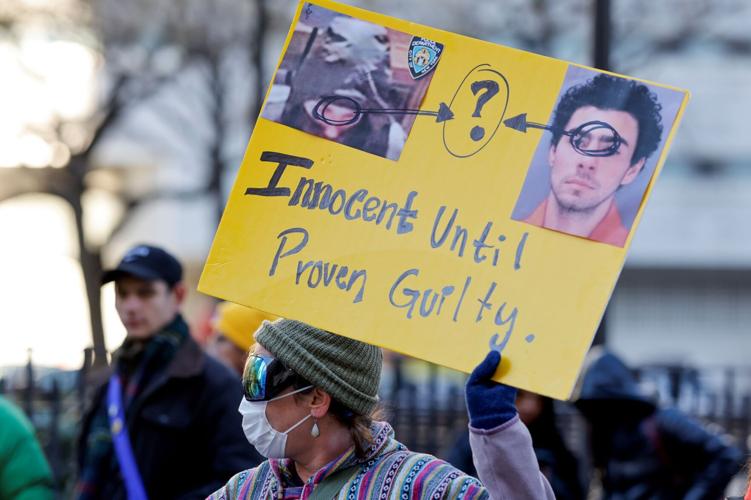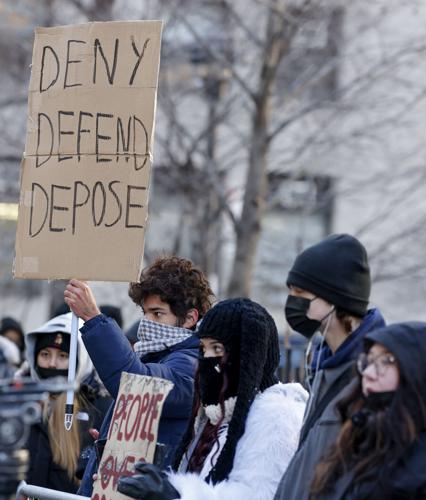WASHINGTON — Most Americans believe health insurance profits and coverage denials share responsibility for the killing of UnitedHealthcare's CEO — although not as much as the person who pulled the trigger, according to a new poll.
In the survey from NORC at the University of Chicago, about 8 in 10 U.S. adults said the person who committed the killing has “a great deal” or “a moderate amount” of responsibility for the Dec. 4 shooting of Brian Thompson.

A demonstrator awaits the arrival of Luigi Mangione for his arraignment Monday at Manhattan Criminal Court in New York.
Despite that, some have cast Luigi Mangione, the 26-year-old suspect charged with Thompson’s murder, as a heroic figure in the aftermath of his arrest, which gave rise to an outpouring of grievances about insurance companies. Police say the words “delay,” “deny” and “depose” were scrawled on the ammunition investigators found at the scene, echoing a phrase commonly used to describe insurer tactics to avoid paying claims.
People are also reading…
UnitedHealthcare has said Mangione was not a client.
A crowd of people, many supporters, flocked to a New York City courthouse, where Luigi Mangione pleaded not guilty to charges of first-degree …
About 7 in 10 adults say that denials for health care coverage by insurance companies, or the profits made by health insurance companies, also bear at least “a moderate amount” of responsibility for Thompson’s death. Younger Americans are particularly likely to see the murder as the result of a confluence of forces rather than just one person's action.
Americans see a wide range of factors contributing to UHC CEO's killing
The poll finds that the story of the slaying is being followed widely. About 7 in 10 said they had heard or read “a lot” or “some” about Thompson’s death.
Multiple factors were seen as responsible. About half in the poll believe that at least “a moderate amount” of blame is rooted in wealth or income inequality, although they did not think other factors like political divisions in the U.S. held the same level of responsibility.

Demonstrators wait for the arrival of Luigi Mangione for his arraignment in Manhattan Criminal Court on Monday in New York.
Patients and doctors often complain about coverage denials and other complications interfering with care, especially for serious illnesses like cancer and amyotrophic lateral sclerosis, or ALS. Insurance industry critics frequently point to company profits in questioning whether the interests of patients are their top focus.
UnitedHealthcare made more than $16 billion in profit last year, before interest and taxes, on $281 billion in revenue. Insurers frequently note that most of the revenue they bring in goes back out the door to pay for care. UnitedHealthcare said this month that it pays about 90% of medical claims when they are submitted. The insurer has not provided details about how many claims that involves.
Americans under 30 are especially likely to think a mix of factors is to blame for Thompson’s death. They say that insurance company denials and profits are about as responsible as Thompson’s killer for his death. About 7 in 10 U.S. adults between 18 and 29 say “a great deal” or “a moderate amount” of responsibility falls on profits made by health insurance companies, denials for health care coverage by health insurance companies or the person who committed the killing.
Young people are also the least likely age group to say “a great deal” of responsibility falls on the person who committed the killing. Only about 4 in 10 say that, compared with about 6 in 10 between 30 and 59. Roughly 8 in 10 adults over 60 say that person deserves “a great deal” of responsibility.
About two-thirds of young people place at least a moderate level of blame on wealth or income inequality, in general.
People under 30 are more likely to place blame on the media, with 54% saying that compared with about one-third of older adults.
About 3 in 10 struggled with coverage from health insurance in the last year
Frustrations with health insurers, coverage and the complicated U.S. health care system have been simmering for years among patients.
About 3 in 10 Americans say they have had a problem getting coverage from their health insurer in the last year, whether those involved problems finding a suitable provider in-network, a claim getting denied or issues getting prior authorization or insurer approval before care happens. These struggles are more prevalent among Americans under 60.
UnitedHealthcare says prior authorizations help eliminate waste in the system and let people know whether care will be covered before it is delivered. It says less than 2% of the insurer’s customers experience a denial of care from prior authorizations annually.
Roughly 3 in 10 in the poll say immediate family or close friends have experienced problems getting coverage from their health insurer in the last year. Americans under 30 are among the most likely to say they don’t have health insurance.
Most Americans get health coverage through their job or by purchasing individual policies. Separate, government-funded programs provide coverage for people with low incomes or those who are age 65 and over or have severe illnesses or disabilities.
The Cost of Health Insurance for Employees and Employers by State
The Cost of Health Insurance for Employees and Employers by State

Photo Credit: Andrey Popov / Shutterstock
Health insurance is a crucial component of employee compensation, typically representing the largest benefit expense for companies outside of wages. As healthcare costs continue to rise in the United States, access to competitive health insurance is vital for employees, who rely on these benefits to mitigate the growing costs of care. For employers, offering comprehensive health insurance packages is an essential tool not only for attracting talent, but also for retaining workers who might otherwise seek positions offering better coverage.
Employer-sponsored plans remain the primary source of health insurance for most Americans under 65 and their families, covering nearly 165 million people in 2023. However, the cost of providing these benefits is becoming increasingly difficult for both employees and employers. Projections for 2025 indicate that healthcare costs will increase by 8%, reflecting the continued pressure of rising prices.
This analysis explores the cost of health insurance over time, by firm type, and by location, shedding light on the financial implications for employers and employees nationwide.
How Fast Are Health Insurance Premiums Rising?

Over the past two decades, health insurance premiums have risen far faster than the rate of inflation
Take Command analysis of U.S. Department of Health & Human Services data | Image Credit: Take Command
Rising premiums for employer-sponsored insurance have increasingly outpaced inflation and wage growth, driving up costs for firms and employers across the economy. In 2000, the average premium for single coverage (combined employer and employee contributions) was $4,698 in 2023 dollars, with employees contributing $796 and employers covering the remaining $3,902. By 2023, average premiums had risen to $8,182, with employees contributing $1,640 on average and employers covering $6,542. This reflects an inflation-adjusted increase of 74% over 23 years.
For family coverage, the rise has been even more pronounced. In 2000, the average inflation-adjusted premium for family coverage was $11,983, with employees contributing $2,856 and employers covering $9,127. By 2023, average family coverage premiums had grown to $23,938, a doubling over two decades. Employees now contribute an average of $6,889 annually for family coverage, while employers cover $17,049.
In addition to rising premiums, the share of health insurance costs covered by employees has also increased over time. In 2000, employees contributed 16.9% of the total premium for single coverage and 23.8% for family coverage. By 2023, these contributions had grown to 20.0% for single coverage and 28.8% for family coverage—a shift that has transferred a larger portion of the healthcare cost burden to employees.
Health Insurance Costs by Firm Size

Midsize employers contribute the least to employee health benefits
Take Command analysis of U.S. Department of Health & Human Services data | Image Credit: Take Command
Employees at midsize companies (25–99 employees) generally pay more for healthcare coverage while receiving less employer support than workers at smaller and larger firms. For single coverage, midsize firm employees contribute an average of $1,810 annually, compared to the 2023 national average of $1,640 across all firms. For family coverage, employees pay an average of $8,839, significantly higher than the national average of $6,889 and higher than that paid by employees in any other firm-size cohort.
In contrast, employer contributions at midsize companies remain lower than average. For single coverage, midsize firms contribute $5,916 on average, compared to the national employer average of $6,542. Similarly, for family coverage, midsize employers contribute $13,662—well below the $17,049 average across all firms.
The trend of employee contributions being lowest at both the smallest and largest firms, in both percentage and dollar terms, is shaped by several factors. Small firms often benefit from tax credits that help offset healthcare costs, enabling them to cover a larger share of premiums without significantly increasing their financial burden. Large firms, on the other hand, typically have the resources to invest more heavily in employee benefits, using competitive healthcare coverage as a tool to attract and retain top talent. Midsize firms, however, often fall into a “middle ground,” lacking access to both tax incentives and the financial capacity of larger corporations. As a result, they tend to offer lower employer contributions, which shifts a larger share of healthcare costs onto employees.
Health Insurance Costs by Industry

Professional & financial services employers face the highest health insurance premiums
Take Command analysis of U.S. Department of Health & Human Services data | Image Credit: Take Command
High-paying industries, such as professional services, financial services, and real estate, tend to have some of the highest health insurance premiums. In these sectors, employers often provide more comprehensive coverage to align with competitive compensation packages, leading to higher overall premium costs. For single coverage in professional services, the average total premium is $8,653, and in financial services and real estate, it is $8,569—both well above the national average. Family coverage premiums follow a similar pattern, with both sectors averaging around $24,800 annually.
Despite these higher premiums, employees in these industries contribute amounts similar to national averages. In professional services, employees pay $1,648 for single coverage and $7,091 for family coverage costs, just slightly above national contribution rates. In financial services and real estate, employee contributions are below average. This is possible due to the higher profitability and financial resources in these sectors, allowing employers to absorb more of the premium cost while maintaining attractive benefits for employees.
Regional Differences in Employer Health Plan Costs

Neighboring New Jersey, Massachusetts, and New York face the highest health insurance premiums
Take Command analysis of U.S. Department of Health & Human Services data | Image Credit: Take Command
Health insurance premiums vary widely across the U.S., with the highest costs concentrated in Northeastern states. New Jersey, Massachusetts, and New York report the highest average premiums for both single and family coverage. In 2023, the average premium for single coverage in New Jersey reached $9,662, while family coverage in the state cost an average of $26,870—both well above the national averages of $8,182 for single and $23,938 for family coverage. Neighboring states Massachusetts and New York follow closely behind, with family coverage premiums averaging $26,355 in each.
High premiums in the Northeast reflect the region’s high per capita healthcare spending, which according to the U.S. Centers for Medicare & Medicaid Services is about 25% greater than the national average. Additionally, states in this region often have more comprehensive healthcare mandates and regulations, which can result in higher premiums.
In contrast, states in the South and parts of the Midwest report some of the lowest average premiums. For instance, in Mississippi, the average premium was $7,243 for single coverage and $21,939 for family coverage in 2023. These lower premiums may reflect lower healthcare spending per capita, less comprehensive plans offered by employers, and fewer mandates that affect plan coverage requirements.
For businesses looking to mitigate the cost of rapidly rising employer-sponsored health insurance premiums, there are a few options to consider. Partnering with a Professional Employer Organization (PEO) allows small and medium-sized businesses to co-employ their staff, granting access to the PEO’s larger health insurance pool with more competitive rates and administrative support. Alternatively, Association Health Plans (AHPs) enable small businesses to band together and leverage their collective purchasing power for better rates and coverage. For an affordable, tax-advantaged solution, Health Reimbursement Arrangements (HRAs) allow employers to reimburse employees for individual insurance premiums and medical expenses on a pre-tax basis, offering flexibility and significant savings. These strategies help businesses manage costs while providing individualized health benefit options.
Below is a breakdown of health insurance premiums by state and metropolitan area. The analysis was conducted by Take Command—a platform that helps companies provide health benefits to employees through Health Reimbursement Arrangements—using data from the U.S. Department of Health and Human Services. For more information, see The Cost of Health Insurance for Employees and Employers by State on Take Command.
Health Insurance Premiums by State

Health Insurance Premiums by Metro

Methodology

Photo Credit: Andrey Popov / Shutterstock
The data used in this study is from the Agency for Healthcare Research and Quality’s Medical Expenditure Panel Survey (MEPS), an initiative under the U.S. Department of Health and Human Services. The current annual survey covered more than 42,000 private sector establishments and was released in July 2024. To determine the cost of employer-sponsored health plans, researchers at Take Command calculated the employee and employer contribution amounts using average premiums across single- and family-coverage plans. Unless otherwise specified, all statistics shown are averages for 2023 and represent private sector firms only. All 50 states and select metropolitan areas tracked by MEPS were included in the analysis. Importantly, certain metropolitan areas that span multiple states are listed more than once, each with the corresponding state, due to significant differences in health insurance costs across state lines.
For complete results, see The Cost of Health Insurance for Employees and Employers by State on Take Command.














